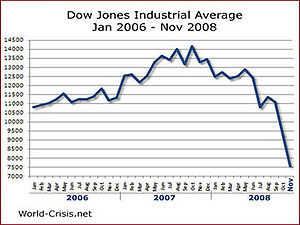Our people are dealing with complex problems. We’d like to bring you in so you can stimulate a thoughtful conversation, and hopefully stir up some big ideas that will take us forward.”
As a self-employed leadership consultant, I used to hear this kind of thing a lot, mostly before the 2008 financial crisis. ...
 |
| English: Dow Jones Industrial Average Jan 2006- Nov 2008 中文(简体)‬: 道琼斯工业平均指数(2006年1月-2008年11月) (Photo credit: Wikipedia) |
“One thing you need to know is that our folks are very busy. They don’t have the time or bandwidth to deal with a lot of big-picture concepts or ideas about the future. What they want are a few simple takeaways––three things they can do on Monday morning.”
Leaving aside the question of whether the leaders in question are really looking for three things to add to their already jammed Monday calendars, I find myself increasing skeptical of this approach. It seems to be based on a faulty understanding of what professionals operating in a complex and demanding environment actually require. Harried and rushed, distracted by technology overload, struggling with compliance issues that keep them mired in a welter of detail, and assailed by requests whose claims of urgency have become routine, the executives I meet these days often seem to be in need of refreshment and renewal rather than additional to-do’s.
Instead of three tips on how to manage invasive technologies, leaders need opportunities to articulate a broad vision of what they’re trying to achieve, so they can better distinguish which tasks require diligence and which can be let go. Instead of exhortations about the need to “manage up,” they need to understand how the erosion of barriers that defined industrial-era culture is leaving the employees they manage exposed to uncertainty and fear. Instead of quick fixes to address shifting markets, they need support to recognize how intersecting trends are creating whole new categories of unmet needs. ...
... By focusing potentially profound conversations on three action points or five bullets, those who plan seminars and retreats risk squandering the opportunity for thoughtful engagement and short-circuiting creative solutions that smart people, given the time and permission to think, are likely to come up with on their own.
Being able to shoot the rapids in an era of constant change requires robust thinking skills. People do not develop these skills by responding to prescriptive formulas, however neatly packaged as takeaways. Planting seeds that may germinate in the coming years is also a useful antidote to the sense of unrelenting urgency that pervades organizational life and that can undermine peoples’ ability to make good decisions.
 |
| Solution of the Nine Dots puzzle (Photo credit: Wikipedia) |











No comments:
Post a Comment